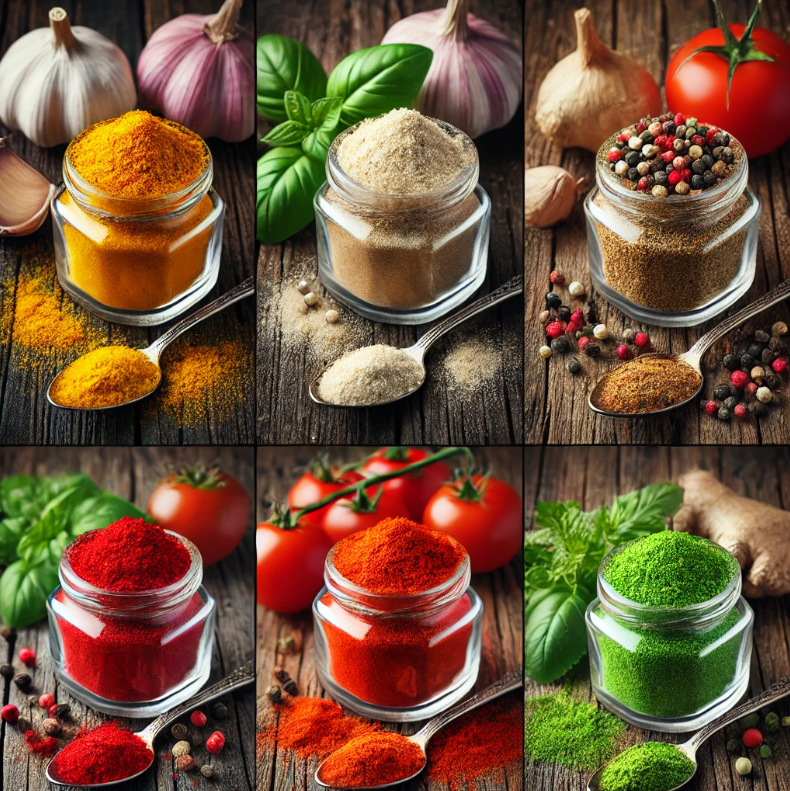Herbs and vegetables are the cornerstone of vibrant, delicious meals. But keeping them fresh can be a challenge. Why let these culinary staples go to waste when you can transform them into long-lasting, nutrient-rich powders right at home? By making your own herb and vegetable powders, you preserve their essence, avoid preservatives, and enjoy unparalleled flavor. Here’s your ultimate guide to creating homemade powders from mint, coriander, ginger, garlic, tomato, and onion.

Why Choose Homemade Powders?
Creating your own herb and vegetable powders offers several benefits:
Unmatched Freshness: Homemade powders capture the natural aroma and taste far better than store-bought alternatives.
No Preservatives: They’re completely chemical-free, ensuring a healthier choice for you and your family.
Cost-Effective: Save money by making use of seasonal produce or surplus harvests.
Versatile Uses: These powders are multipurpose, enhancing everything from soups to snacks.
Essential Powders to Elevate Your Cooking

1. Mint Powder
Preparation:
Wash fresh mint leaves thoroughly to remove dirt. Pat them dry with a clean cloth and remove the stems.
Spread the leaves on a tray in a well-ventilated area away from direct sunlight. This helps retain their vibrant green color.
Grinding:
Once the leaves are crisp and dry, grind them into a fine powder using a blender or mortar and pestle. Store in an airtight jar to preserve the flavor.
Usage:
Add mint powder to teas, raita, chutneys, and marinades for a refreshing kick.
2. Coriander Powder
Preparation:
Wash and chop fresh coriander leaves, including tender stems, for faster drying.
Lay them on a cotton cloth in a shaded area to dry completely while retaining their natural green hue.
Grinding:
Grind the dried leaves into a fine powder. For an extra burst of flavor, mix in a pinch of roasted cumin seeds before grinding.
Usage:
Enhance curries, soups, and sauces with the bright, herby flavor of coriander powder.
3. Ginger Powder
Preparation:
Peel fresh ginger roots and cut them into thin slices or grate them.
Spread the ginger pieces evenly on a tray and dry them in indirect sunlight until they’re completely dehydrated.
Grinding:
Blend the dried ginger into a fine powder and sift to remove any fibrous particles.
Usage:
Perfect for teas, cookies, and savory dishes, ginger powder adds a warm, spicy note.
4. Garlic Powder
Preparation:
Peel fresh garlic cloves and slice them thinly.
Arrange the slices on a flat surface and dry them in indirect sunlight or use a dehydrator for quicker results.
Grinding:
Grind the dried slices into a fine powder and store in an airtight container to lock in the aroma.
Usage:
Sprinkle garlic powder over pizzas, stir-fries, or roasted vegetables for a flavorful punch.
5. Tomato Powder
Preparation:
Wash ripe tomatoes and cut them into small pieces, removing seeds if desired.
Dry the pieces thoroughly under the sun or in an oven at low heat until completely dehydrated.
Grinding:
Grind the dried tomatoes into a fine powder.
Usage:
Use tomato powder to enrich soups, stews, and sauces, or as a seasoning for snacks.
6. Onion Powder
Preparation:
Peel and slice onions thinly.
Spread the slices on parchment paper or a clean cloth and dry them in sunlight or a dehydrator.
Grinding:
Grind the dried onion slices into a smooth powder and store in an airtight jar.
Usage:
Enhance soups, stews, salad dressings, or spice blends with the savory depth of onion powder.
Tips for Perfect Homemade Powders

- Complete Dryness is Key: Any moisture can lead to spoilage or mold, so ensure ingredients are fully dried.
- Protect from Direct Sunlight: Dry herbs and vegetables in indirect sunlight to preserve their nutrients and color.
- Store Airtight: Keep powders in sealed containers to maintain freshness and prevent clumping.
- Label and Date: Mark jars with the name and preparation date to track freshness.
Why Make These Powders at Home?
Homemade herb and vegetable powders aren’t just a convenience—they’re a culinary treasure. They save time in the kitchen while delivering bold, fresh flavors. Plus, you gain peace of mind knowing exactly what’s in your food.
Conclusion
Transforming fresh herbs and vegetables into powders is an easy, rewarding process that ensures your pantry is always stocked with natural, chemical-free ingredients. From mint powder for refreshing drinks to tomato powder for hearty sauces, these DIY staples elevate every meal. Give these recipes a try and enjoy the magic of homemade flavor in your cooking.
Disclaimer: Always clean and thoroughly dry your herbs and vegetables to ensure safety and quality. Store powders in a cool, dry place for optimal results.
Inspired by this? Share the idea with your friends and revolutionize your kitchen!





